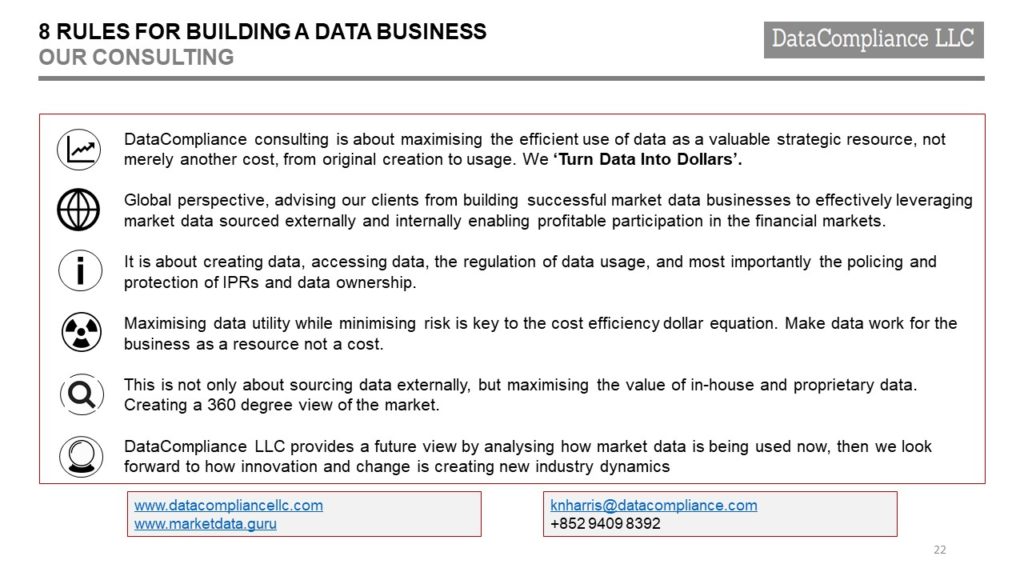Rule 8 Objective: Make sure dollars follow data. Identify all participants in the data workflow from source to consumption to provide market intelligence for developing future business strategies and efficient revenue models
Why? Getting to know the data workflows builds a better understanding of what is happening to the data and who/what the data is interacting with. As the data flows, so ought the revenue, which is too often not the case for many business right now. Revenue leakage (I have seen an average of 22%) is a major issue for data sources and market data vendors because the data workflows and usage become obscured, or, remain only partially understood or known.
While data workflows can be complex, building upon basic principles creates a continuous understanding of what is happening to the data, by who, how, and for what purpose, thereby enabling IPRs, business strategies, pricing models and partnerships to stay relevant, avoid stagnation, while maximising revenue. The data business must also stay on top of the many alterations to data flows, both those occurring naturally and those frequent deliberate course changes. There are many data Hercules willing and able to divert rivers to clean out their own versions of the Augean Stables.
The Key factors are:
• Understanding data workflows, and the way these change and adapt builds business success
• It is all about Source. Quality. Flow. Fees.
• Data workflows create intelligence, especially as market dynamics change, often radically, because:
• More participants get involved
• Different types of users emerge
• The multiple ways of using data evolve and become more imaginative in concept and application
• New markets and opportunities open up (for example, especially in mass retail)
 Rule 8 Future Development
Rule 8 Future Development
Knowing data workflows will only increase in importance given its relative impact to revenues. What is surprising is that this type of approach is only a recent phenomenon. Businesses must eschew a linear approach to workflows because the data is functioning in a multi-dimensional environment. This means deploying best practice, and efficient, operational oversight.
How?
• Build a picture of the data workflows, get to know each players’ role and responsibilities
• Improved and comprehensive reporting is a necessity, but few data sources, exchanges, and vendors do this well, and many barely adequately, this really ought to be a priority because it involves large sums of money
• Reporting also means asking the right questions, or else, rubbish in, rubbish out
• The data workflow must be 100% electronic (no honesty statements, guesses, subjectivity) and built around the 3 cardinal principles of:
- Data Control. There must be systems in place (permissioning/entitlements) that enable data to be turned on and off to known users, human or non-human, and all users must be known
- Data Monitoring. Each, and every, change to users and usage must be known and recorded. With the advent of tools which can measure in real time usage changes (like Crizit for reference data) this now becomes a cost control as well as a compliance benefit
- Data Reporting. A full audit trail of data usage and changes to data users, including who, and when must be 100% accurate and maintained
• Reporting should be analysed, again there is tendency not to evaluate usage reports or carry out due diligence on them
• If data consumers refuse to play by the rules, the data owner must not fear the ultimate sanction, turn off the data flow •
Getting Rule 8 right matches revenue to usage and reduces the curse of revenue leakage by tracking the data workflows
8 Rules Summary to come!
Keiren Harris 28/03/2021
Please email knharris@marketdata.guru for a pdf or information about out consulting services


